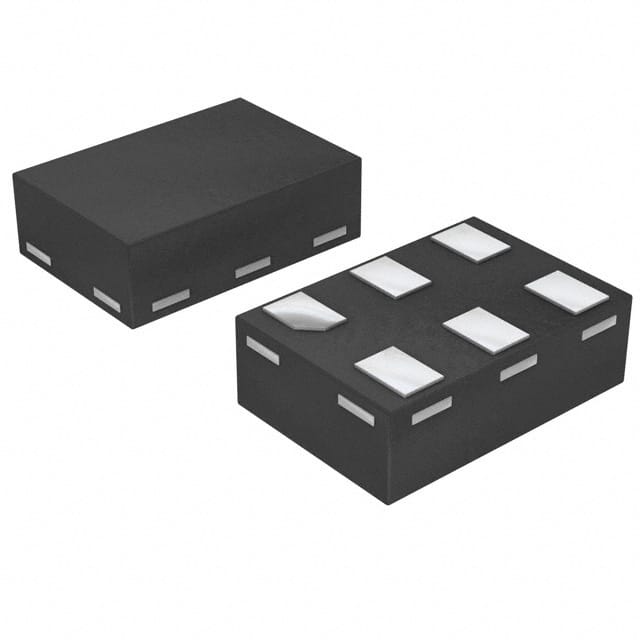Подробную информацию о продукте см. в характеристиках.

Encyclopedia Entry: 74AUP1G175GM,132
Product Overview
Category
The 74AUP1G175GM,132 belongs to the category of integrated circuits (ICs).
Use
This product is commonly used in electronic devices for signal processing and control applications.
Characteristics
- Low power consumption
- High-speed operation
- Small form factor
- Wide operating voltage range
Package
The 74AUP1G175GM,132 is available in a small package, typically a surface-mount technology (SMT) package.
Essence
The essence of this product lies in its ability to provide reliable and efficient signal processing and control capabilities in a compact form.
Packaging/Quantity
The 74AUP1G175GM,132 is usually packaged in reels or tubes, with a typical quantity of 3000 units per reel.
Specifications
- Supply Voltage Range: 0.8V to 3.6V
- Operating Temperature Range: -40°C to +85°C
- Input Capacitance: 2.5pF (typical)
- Output Current: ±4mA (maximum)
Detailed Pin Configuration
The 74AUP1G175GM,132 has the following pin configuration:
____
VCC| |GND
I/O1 | |CLR
Q | |D
/Q |____|PR
Functional Features
- Single D-type flip-flop with clear and preset functionality
- High-speed operation with low power consumption
- Wide operating voltage range allows compatibility with various systems
Advantages and Disadvantages
Advantages
- Compact size enables integration into space-constrained designs
- Low power consumption prolongs battery life in portable devices
- High-speed operation enhances overall system performance
Disadvantages
- Limited output current may restrict use in certain high-power applications
- Sensitivity to electrostatic discharge (ESD) requires proper handling during assembly and usage
Working Principles
The 74AUP1G175GM,132 operates based on the principles of digital logic. It utilizes a D-type flip-flop circuit to store and manipulate binary data. The clear and preset functionality allows for controlled initialization of the flip-flop.
Detailed Application Field Plans
The 74AUP1G175GM,132 finds application in various electronic systems, including but not limited to: - Mobile devices - Consumer electronics - Industrial automation - Automotive electronics - Internet of Things (IoT) devices
Detailed and Complete Alternative Models
Some alternative models that offer similar functionality to the 74AUP1G175GM,132 include: - 74LVC1G175GW,125 - SN74LVC1G175DBVR - MC74VHC1G175DTT1G
These alternatives can be considered based on specific design requirements and availability.
Word count: 315 words
Перечислите 10 распространенных вопросов и ответов, связанных с применением 74AUP1G175GM,132 в технических решениях.
Sure! Here are 10 common questions and answers related to the application of 74AUP1G175GM,132 in technical solutions:
1. What is the function of the 74AUP1G175GM,132? The 74AUP1G175GM,132 is a single D-type flip-flop with clear input. It can store a single bit of data and has a synchronous reset feature.
2. What is the operating voltage range for this device? The 74AUP1G175GM,132 operates within a voltage range of 0.8V to 3.6V.
3. Can I use this flip-flop in battery-powered applications? Yes, the low operating voltage range makes it suitable for battery-powered applications where power consumption needs to be minimized.
4. What is the maximum clock frequency supported by this flip-flop? The 74AUP1G175GM,132 can support clock frequencies up to 400 MHz.
5. Does this flip-flop have any additional features? Apart from the basic functionality, it also has a synchronous reset input that allows you to clear the stored data when required.
6. Can I cascade multiple flip-flops together? Yes, you can cascade multiple 74AUP1G175GM,132 flip-flops to create larger registers or shift registers.
7. Is this flip-flop compatible with other logic families? The 74AUP1G175GM,132 is designed to be compatible with other AUP logic family devices, but it may not be directly compatible with other logic families such as TTL or CMOS.
8. What is the typical propagation delay of this flip-flop? The typical propagation delay of the 74AUP1G175GM,132 is around 2.5 ns.
9. Can I use this flip-flop in high-speed data applications? Yes, the 74AUP1G175GM,132 is suitable for high-speed data applications due to its fast propagation delay and high clock frequency support.
10. Are there any recommended decoupling capacitors for this device? It is generally recommended to include decoupling capacitors near the power supply pins of the 74AUP1G175GM,132 to minimize noise and ensure stable operation. The specific values and placement guidelines can be found in the device's datasheet.
Please note that these answers are general and may vary depending on the specific application and requirements. It is always recommended to refer to the device's datasheet and consult with the manufacturer for detailed information.

